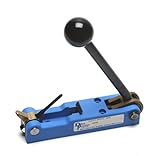The Ins & Outs

Last year I posted an article covering the creation of .300 Blackout cartridges from fired .223/5.56 NATO brass. But l may have put the cart before the horse. Knowing how to reload 5.56 brass is probably the first step. The Blackout still has strong interest, and it fills a useful niche, but sales of .223 Remington/5.56 NATO ammunition still outpace it by a huge margin.
AR-15 sales remain brisk as well. The platform has evolved to encompass a number of interesting calibers, but most are still chambered to fire the ubiquitous “5.56.” So, putting two and two together, many AR owners must be sitting on copious collections of fired cases. And if they happen to be brass boxer-primed versions, they represent a source of renewable ammunition.
But for those with no reloading experience, learning how to reload 5.56 brass can be a challenge. The logical starting point is knowledge, a basic understanding of the process. That’s the key to procurement of other the essentials; equipment and components. Right off the bat though, I’ll just say you won’t get the full low-down from a short article like this one.
Reloading isn’t rocket science, but the fine points need to be understood. Which takes us back to the above paragraph.
.223 vs 5.56 – What’s the Difference?
Dimensionally, there’s no real external difference between a .223 Remington and 5.56 x 45 NATO cartridge; in fact, the latter is just an offshoot tweaked for military use via a pressure increase. That boost provided the slight velocity gain needed to satisfy NATO’s range and penetration standards. However, a bit of additional chamber length was required to give the bullets a safe running start.
Because a standard .223 Remington chamber lacks this additional clearance, a switch to warmer 5.56 NATO rounds could result in unsafe pressures. No worries in reverse though; you can safely fire .223 cartridges through a 5.56 NATO chamber. FYI, a “Wylde” chamber is designed to safely fire either load, often with excellent accuracy.
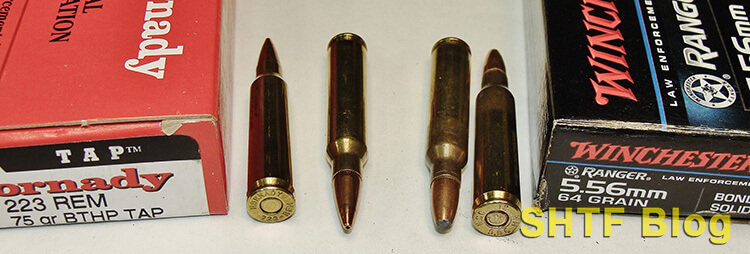
A possible issue for reloaders: military brass can run a tad thicker, resulting in a minor capacity decrease. Thus, some otherwise safe .223 powder charges could elevate pressures in 5.56 cases – one reason (of several) why reloaders should never begin with “maximum” loads. Instead, we work our way up while watching for signs of excessive pressures – a topic onto itself.
Why Brass Cases?
Various materials have been used to create cartridge cases to include polymers, aluminum, steel, and brass. But brass has always been an ideal metallic cartridge choice because of its malleability. When fired the cartridge case must expand against the chamber walls to prevent dangerous pressure escapes – and it must also contract to allow extraction.
For all of the above materials – except brass – this process is a one-shot deal. But thanks to its elasticity, a brass case can be safely “resized” to its original dimensions for multiple loadings. Steel-cased ammo is usually more affordable, but it won’t work. If you’re contemplating rolling your own cartridges, you’ll need brass cases.
Boxer Primed?
The vast majority of American centerfire cartridges are boxer-primed, whereas the Berdan system is more common in Europe. The latter can be reloaded, but the process is much more complicated. Fortunately, it’s easy to tell them apart through a peek inside a fired case. A Berdan-primed case has two small opposing holes in its base.
A boxer-primed case has one central flash-hole, meaning it fired primer can be popped free via a “decapping pin” – a relatively simple process. U.S. reloading equipment is designed for these cases, but military-type 5.56 brass needs an extra step. Due to the rigors of full and semi-auto feeding the primers are “crimped” in place.
When the fired primer is removed a small annular lip will remain which must be eliminated prior to repriming. It’s an easy chore to perform with the right equipment, but it adds an extra step to case preparation.
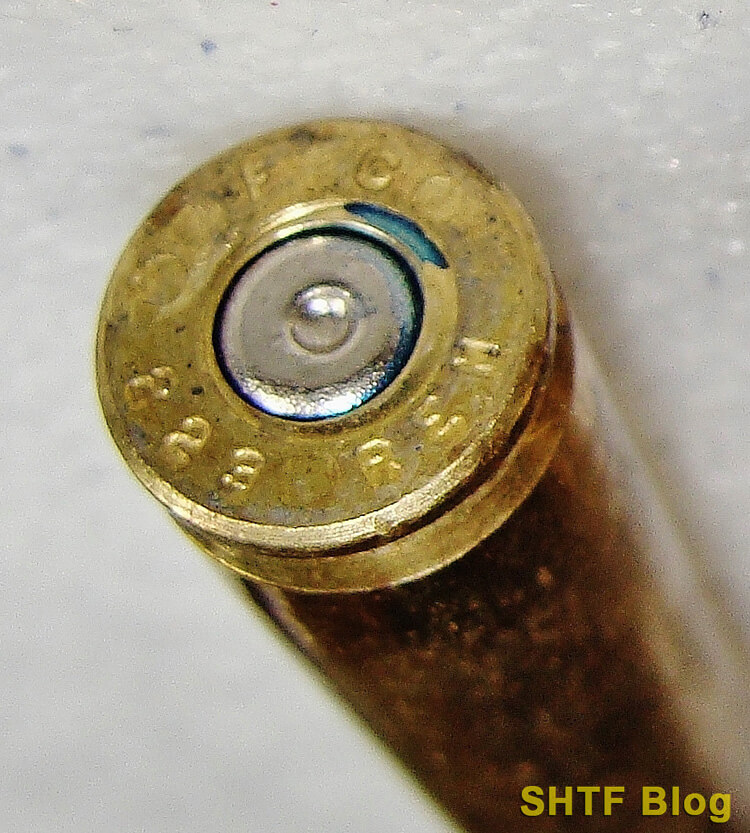
How to Reload 5.56
Assuming you have a suitable supply of brass, the logical first step is base-level knowledge. One good source has always been the reloading manuals sold by major component manufacturers. Most list caliber-specific loads for a large variety of popular cartridges, and many also include useful “how to” chapters.
As for components, the possibilities for most calibers are daunting, and sailing into uncharted waters is a recipe for disaster. But by sticking to the manuals, the recipes will be proven through empirical velocity and pressure tests. However, by their nature, these publications are more generic. Toss .223/5.56 into the same mix as a gas-operated semiautomatic like the AR-15 and system-specific concerns will arise. Fortunately, Lyman has addressed them through their latest AR Reloading Manual.
- Reloading handbook dedicated to the Modern Sporting Rifle;Reloading data for nearly all AR based calibers;Specialty articles written by popular writers;Data uses all popular brands of bullets and powders;Includes cast bullet data and sub-sonic load
It’s a great starting point for anyone contemplating the reloading of 5.56, as well as other AR-15 based calibers.
The Reloading Process
Reloading begins by resizing a fired cartridge case to its original dimensions. De-priming follows, typically performed by the resizing die. Next comes the seating of a new primer, followed by a charge of powder. The final step is bullet-seating. Result: A useable cartridge of a specified overall length that should function in a magazine-fed firearm.
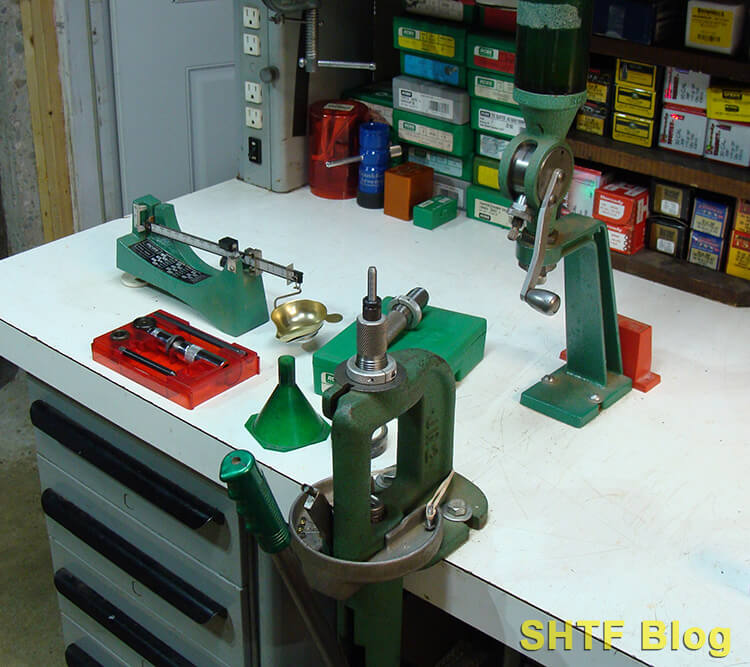
Necessary Equipment
The main items include a reloading press, shell-holder, a set of caliber-specific dies, and a scale to weigh the powder charges. Regarding dies, an upcoming post will cover reloading .30-06 cartridges with a simple Lee Loader kit, which partially resizes cases (via neck-sizing). But reliable function of 5.56 reloads in semi-autos demands the use of a full-length resizing die and the mechanical leverage of a press.
The good news is, most come with priming systems, and they’re threaded to accept all standard dies. The presses’ ram needs the right shell-holder to grasp the cartridge cases, but it’s an inexpensive part. A means to trim cases will also be required. More on that shortly.
Components
Because a cartridge case is the most expensive component, reloads can offer cost savings. This leaves primers, powder, and bullets. But one size won’t fit all. Each must be compatible with the caliber and chosen load – the reason we need a manual!
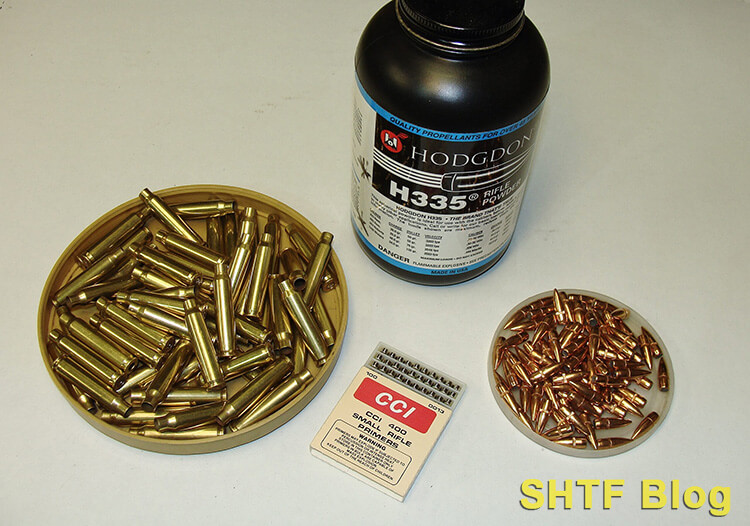
Steps
Most bottle-necked cartridges – like .223/5.56 – are reloaded with a set of two dies. The first die resizes the fired case while simultaneously expelling its primer. The second die seats the projectile. Most can also be adjusted to apply a bullet-gripping crimp to the case mouth.
Actually, both dies must be properly adjusted, but the process is pretty straight-forward, and directions accompany each set. Assuming that’s already happened, let’s go through the steps.
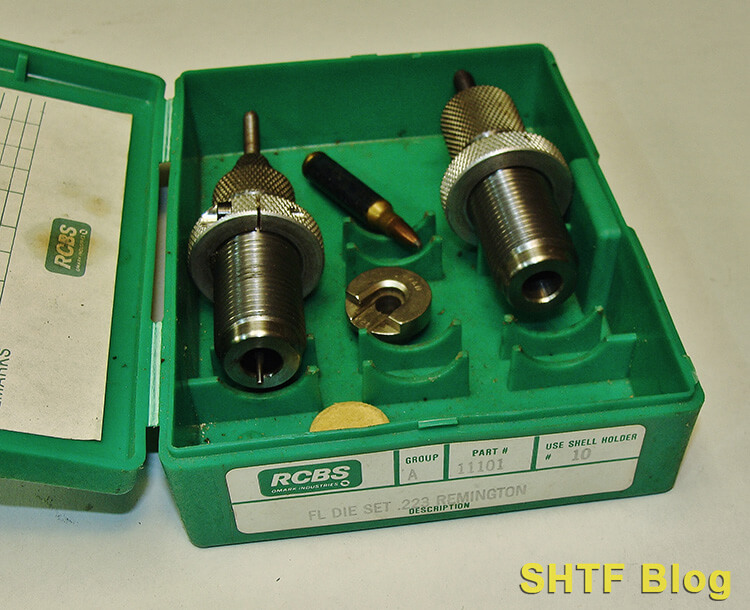
Resizing & De-priming
The resizing die is spun into the press, and the shell holder is snapped into its ram. Then a small dab of case-lube is applied to each case to prevent it from sticking in the die. Next, a case is pushed into the resizing die through the leverage of the press. At the same time, a pin in the center of the die enters the flash-hole to expel the fired primer.
Primer Seating
Several methods exist here. A new primer could be seated via a pivoting arm built into most presses. Other options include hand-held priming gadgets and separate priming presses.
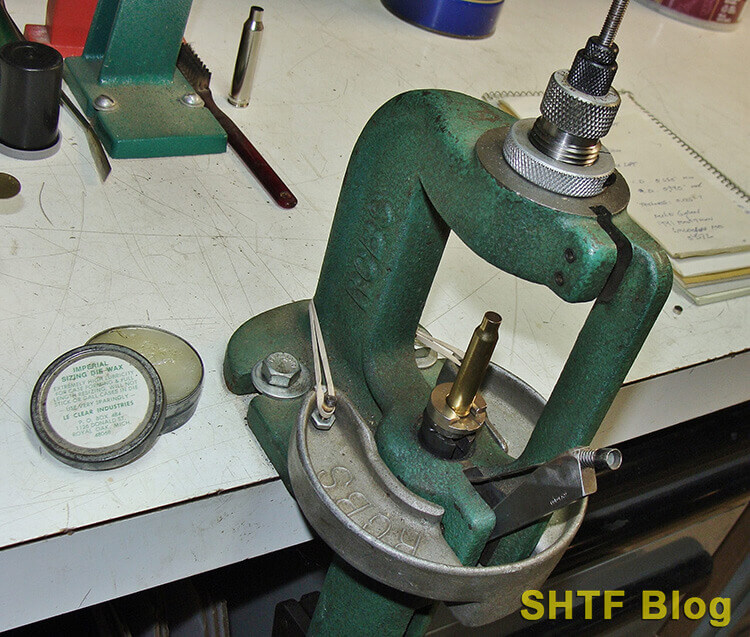
Propellant
For safety’s sake, charges are listed by weight in “grains” – which makes a powder scale essential. Each individual charge could be weighed and dispensed with a funnel, but that takes time. The quicker mass-production alternative is an adjustable powder measure, set to dispense a weight-calibrated charge through each throw of its handle.
Bullet Seating
Switching to the seater die, a primed and charged case is slipped into the shell holder. A bullet is then carefully aligned with its mouth to help guide the bullet into the die. As its tip makes contact with the die’s seater-plug, seating commences. Adjustments to its threaded stem control the seating depth.
As noted above, the die itself can be adjusted to apply a crimp via its internal shoulder (more on this shortly).
Reloading .223 vs 5.56 NATO
I’ve been loading .223 and 5.56 from a set of RCBS .223 Remington dies for several decades and intend to stick with ‘em. Early on, most reloads they produced were destined for .223 bolt-action varmint rifles. In theory at least, tighter .223 chambers have the potential to yield better accuracy than 5.56 NATO versions due to a bit less slop – maybe.
The .223 Remington Side
I own a couple of Dillon high-volume progressive presses, but all of my .223 handloads are assembled on an RCBS single-stage press with TLC. Result: Five-shot groups that have consistently produced half-moa groups from a number of accurate rifles over the years. Most of the brass comes from Federal American Eagle .223 “Q-loads”, fired in large quantities during my agency’s AR-15 range sessions.
The cases get a good cleaning, but that’s about it. I’m not overly hung up on the brand as long as the headstamps are the same – and I know the history of the cases. Consistency being important, I load in batches that have undergone the same number of firings, beginning with once-fired brass. Civilian/sporting .223 cases eliminate crimped primer-pocket hassles (usually). But safety and consistency still require trimming to a specified length.
As it turns out, the same reloads function and shoot well through several AR-15s with Wylde and 5.56 NATO chambers. But, if starting from scratch with the intent of loading for an AR, I’d go a different route.
5.56 x 45 NATO Nuances
Semiautomatic rifles lack the intrinsic camming power of a bolt-actions and as noted above, the ammunition gets a rougher ride. Bullets impact feed-ramp during their transit to the chamber and, as fouling takes its toll, stoppages can occur.
Fortunately, Lyman has addressed these concerns though the perfect complement to their AR-15 Manual; the MSR Precision Die System. Unlike standard two-die sets, it ships with a third die and a cartridge gauge, engineered to improve function in the AR system (it comes with a shell holder, too).
No products found.
The full-length sizer is still there, but it’s a “small-base” version. This design has been around a while. It gives each case a bit of extra squeeze to ensure reliable semiauto chambering.
The seating die is similar to others but, because it lacks a crimping shoulder, it’s only function is bullet seating. Elimination of the shoulder prevents the possible collapse of a cartridge’s shoulder during efforts to apply a tight “roll crimp”.
An additional crimping die provides the neck tension required to grip bullets during their bumpy journey through an AR’s action. Instead of using a shoulder, tension is gradually applied through a taper-crimp.
The fourth item is a go/no-go case-gauge – great insurance against stoppages! The gauge is machined for a 5.56 “chamber.” If a loaded round drops in flush, it’s a “go.” If not, it’s a reject – a whole lot easier to clear from the gauge!
As long as quality components are used, there’s no real reason to expect an appreciable accuracy loss with such a system. In fact, with some combinations, you may see none at all despite the 5.56 NATO chamber – assuming you begin with decent brass.
Case Prep Counts
Again, it’s best to start with clean cases. They don’t need to be spotless, but they should be free of die damaging grit. I batch-clean mine in a vibratory case tumbler and they come out looking minty.
Primer Pocket Prep
Removal of primer pocket crimps is a one-time chore. Of the several methods available on my bench the one I use the most is Dillon’s Super Swage. It’s sorta like a horizontal press and has the leverage to iron out the annoying brass lips in one smooth stroke.
- The Super Swage 600 comes with: Large and small swage rods, .22 and .30 caliber backup rods, A 45ACP adapter.
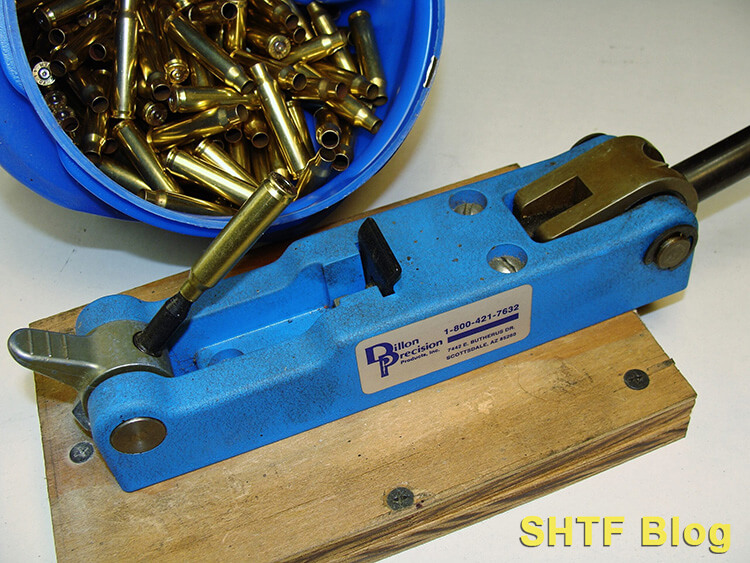
Case Trimming
Cases “grow” through multiple firings, to the point where they can reach unsafe lengths (clearance is required for release of the bullet). And, since consistent crimps are contingent on cases of a uniform length, they should be trimmed prior to their first reload.
Of the several methods on hand I have another a favorite: Little Crow Gun Works sells a cutter/pilot device designed to be spun in a drill. It resembles an oversize chuck, works great when hand-feeding cases, and saves lots of time.
- Works with a cordless or electric drill
- Trims at least 10 cases per minute
- Does not use pilots, the case is supported by the shoulder and case body
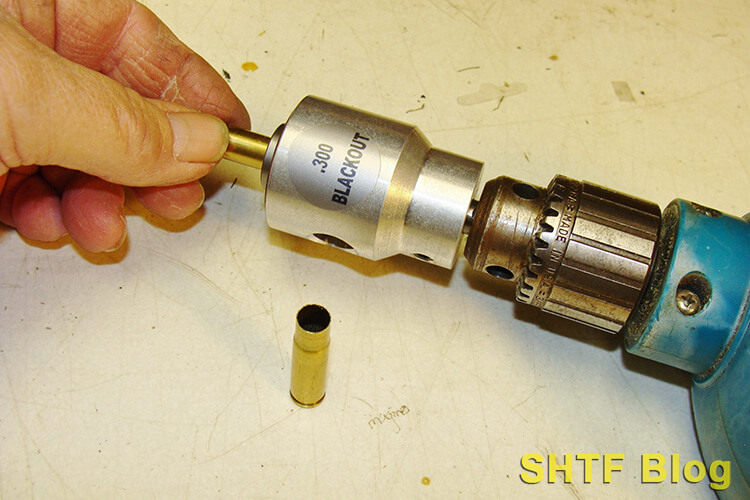
Other Items
Once the cases are trimmed, they’ll need to be de-burred for smooth bullet seating. I clean my primer pockets after each firing; others don’t. Inexpensive hand-tools can tackle these chores, or you can go all-in for an electric case-prep center. Lately, I’ve been using an in-between multi-station unit sold by Hornady.
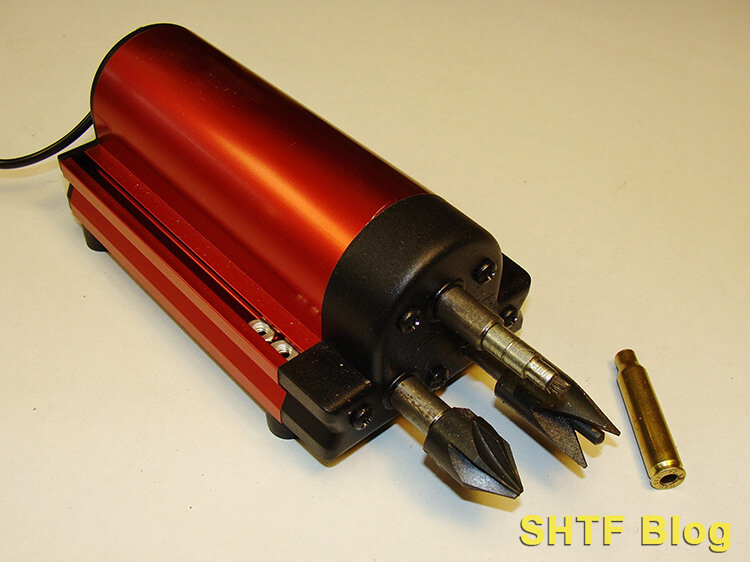
- Hornady Case Prep Trio – The Hornady Lock-N-Load Case Prep Trio helps to make case prep faster and easier without taking up valuable real estate on your reloading bench
- Save Space and Time – Speed up your case prep process and utilize the onboard storage for other 8-32 thread tools. The 3-Tool capacity saves time by having all necessary tools mounted and ready to use. You can chamfer, deburr and clean primer pockets without having to change tools
- Dependable and Easy Case Preparation – This US made unit is assembled with a quiet, high-torque, low speed DC motor housed in a durable brushed aluminum housing to provide years of dependable use
- Features – Comes with both a chamfer and deburring tool with plenty of onboard storage for optional accessories. Compact, portable and quiet with four leveling feet on the bottom
- About Hornady – Founded in 1949, Hornady Manufacturing has become a world-leading innovator of bullet, ammunition, reloading tool and accessory design and manufacturing. At Hornady, ammunition is more than their livelihood. It's a major part of their daily life
One important item for all is an accurate means to determine case and overall cartridge length. The tool for these jobs is a caliper, capable of providing measurements in thousandth-of-an-inch. Of course, a scale is another essential. A powder dispenser isn’t, but it sure will speed up the reloading process – as will cartridge trays and a rabbit hole of other handy items.
And then there’s components. What to buy? That’s where the manual comes in. Lots of load options translate to more component choices – worth knowing in a tight market. Add the right dies and you’ll have the makings of an ammunition factory.
Summary
Is reloading really worth it? The answer really boils down to finances, space, and time. Until recently, factory 5.56 ammunition has been reasonably affordable. But lately prices are creeping upward.
I doubt this situation will improve anytime soon, based on reliable information concerning manufacturer backorders. For this reason, I do my best to maintain a stash of good brass. It’s not only good insurance; turns out the same cases can also keep a .300 Blackout running.


